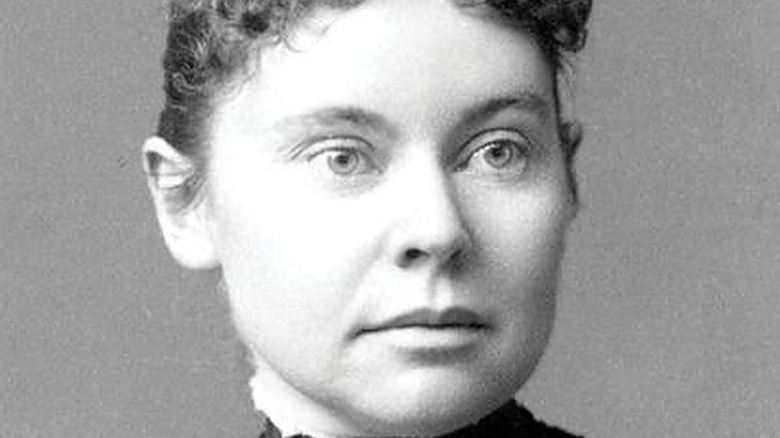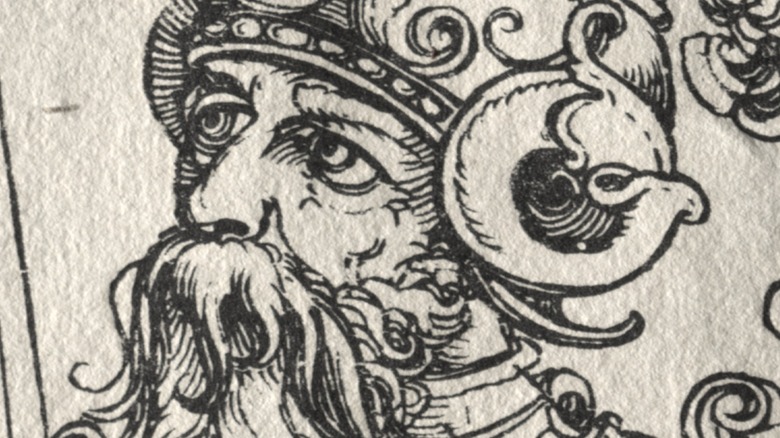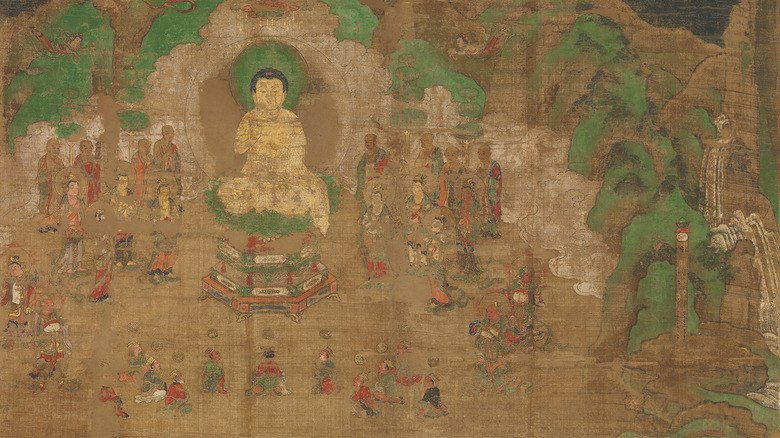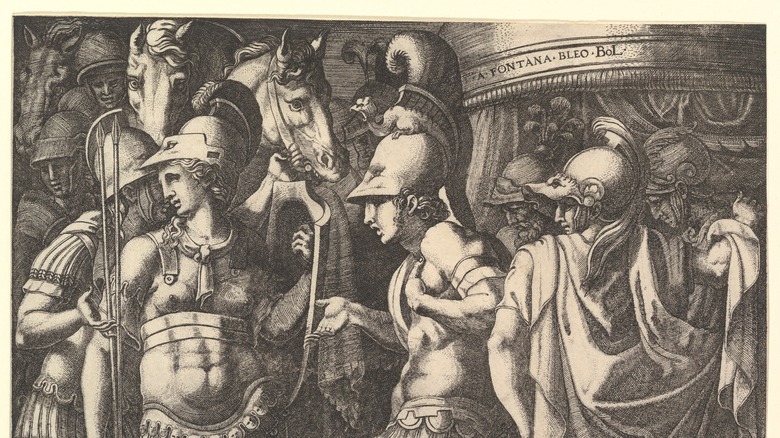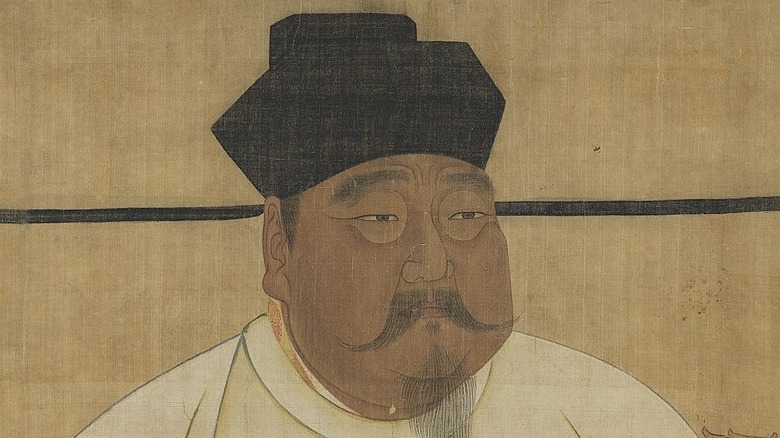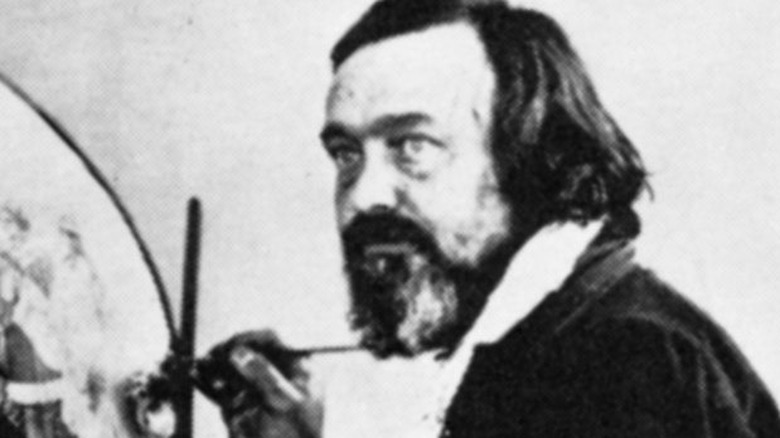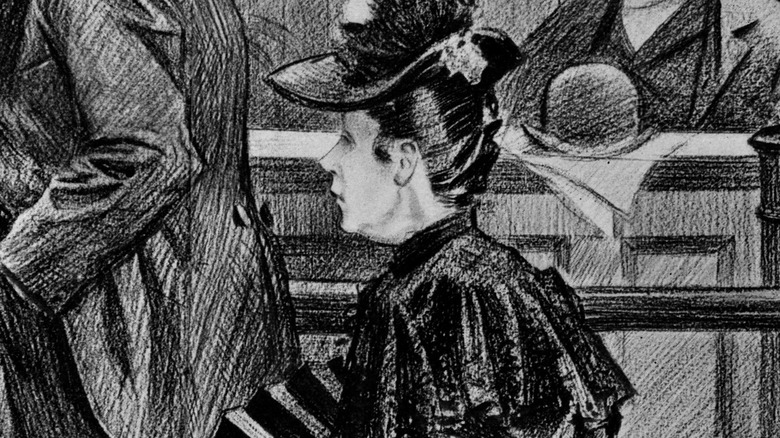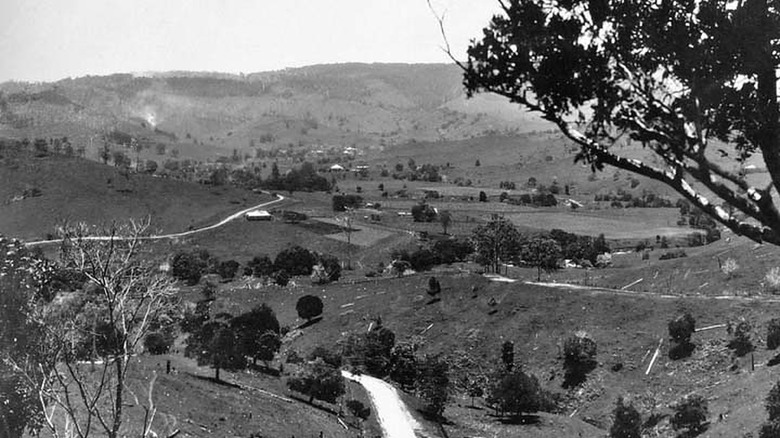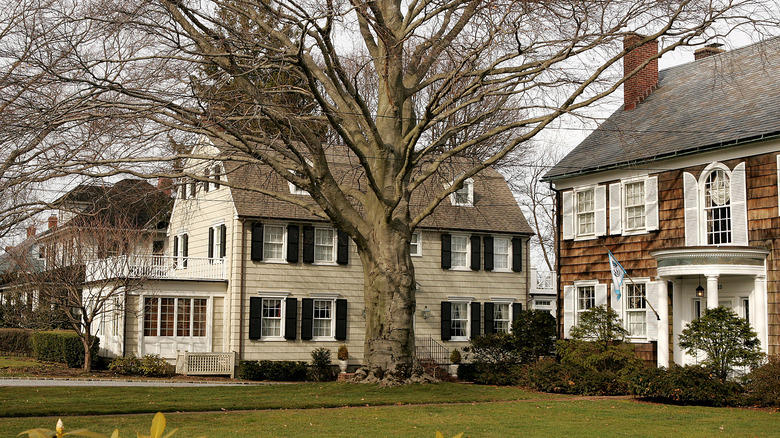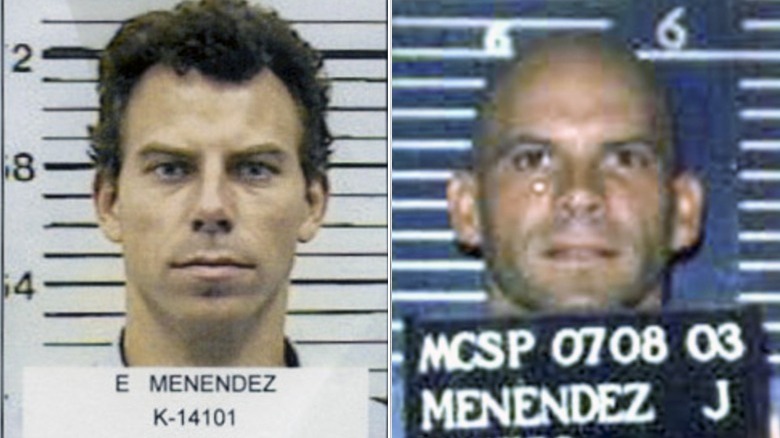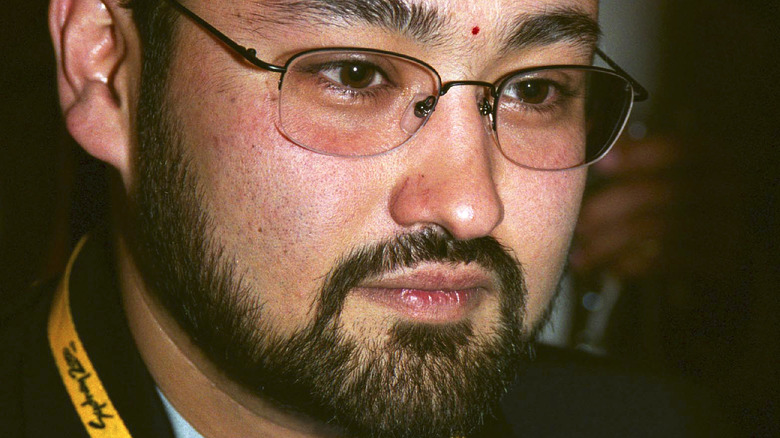Tragic Cases Of Patricide From History
Killing a member of one's own family is one of the ultimate taboos across human history. Patricide, which is defined as killing one's own father, has repulsed and shocked people for thousands of years. Psychiatrists interviewed for an article in The Washington Post about the prevalence of patricide suggested that patricide may only be as rare as it is because of the strength of the taboo against it.
From the myth of Oedipus to the Menendez murders, people have always been desperate to understand what could motivate someone to kill their own father. In these notable cases of patricide throughout history, some appear to have been motivated by a desire for power and advancement such as the cases of kings in the Haryanka dynasty being killed by their heirs, as described in "History of Early India from the Origins to AD 1300." Some, like the case of the artist Richard Dadd (per The Guardian), are the result of tragic illness. Many, like some of those studied by historian and criminologist Lisa Durnian, occurred after years of abuse. Regardless of their reasoning, here are some of the most tragic cases of patricide from history.
The Assyrian king and his heir
King Sennacherib, best known today for his role in the Bible, ruled over Assyria from approximately 705-681 BCE. As noted by Britannica, in addition to fighting multiple campaigns to control the city of Babylon, he also rebuilt the city of Nineveh, transforming it into his kingdom's capital. Around 681 BCE, Sennacherib was killed by one of his own sons.
As described in "The trials of Esarhaddon: the conspiracy of 670 BC," Sennacherib wanted his son Esarhaddon to be his official heir and inherit the crown after his death, but unfortunately his other son Urdu-Mullissi was seen as the next in line. What exactly happened between the father and sons that Sennacherib wanted to replace Urdu-Mullisi with Esarhaddon after more than a decade is unknown, but the king made all of Assyria swear their loyalty to Esarhaddon, while Urdu-Mullissi was forced to step down.
Sennacherib must have known the situation was volatile because the new heir Esarhaddon was sent away to keep him safe from retaliation. Urdu-Mullissi, now demoted, was allowed to remain close to his father, where he hatched a plot with one of his other brothers to kill his father. It is believed that Urdu-Mullissi and his accomplice stabbed their father in the temple of Nineveh. Urdu-Mullissi did not become king, however. His brother Esarhaddon returned with an army to claim his inheritance.
The six Haryanka dynasty patricides
Bimbisara was king of the ancient Indian kingdom Magadha. As stated in "Indian History" he was famously a patron of the Buddha. Bimbisara was an excellent diplomat, sending healers to rival kings and securing marriage pacts between ruling families. He himself had four wives, each a princess from a powerful family. According to one widely believed account, Bimbisara was killed by his own son, and he wouldn't be the last in his dynasty to die by patricide. It is believed that Bimbisara abdicated in favor of his son Ajatashatru, but Ajatashatru was incited by a rival to imprison his father anyway, ultimately allowing him to starve to death. In Jaina tradition, it is believed that Bimbisara died by suicide under similar circumstances.
As described in "History of Early India from the Origins to AD 1300," in 461 BCE, Ajatashatru was also killed by his son. According to tradition, for five generations after, the old king was always killed by his son, who then ascended the throne. This cycle of violent deposition of rulers by their own children is believed to have shocked and horrified the people of Magadha, who ultimately overthrew the fifth king and replaced him with an appointed viceroy.
Alexander the Great's suspected patricide
Before Alexander the Great set out to build his empire, his father, Philip II, was king. As described by History, Philip II is credited with saving Macedonia and setting the stage for later conquests by creating a powerful army. In 336 BCE, Philip II was murdered in front of a crowd by a man named Pausanias, who was Philip's bodyguard and former lover. With so many witnesses, no one could deny who had physically murdered the king, but whether or not Pausanias worked alone has been debated for centuries. Some have suggested that Alexander himself gave the order to kill his father.
Philip II had many lovers, both men and women, throughout his lifetime, including his assassin, Pausanias. There was significant jealousy among his lovers, and one of these rivalries turned violent. Pausanias was brutally attacked, and the king responded by seeking compromise. But Pausanias wasn't satisfied, and many suspected this resentment was a sufficient motive to kill the king. However, others thought someone else concocted the plan.
Many suspected Alexander had arranged the murder so he could control the empire sooner. Alexander himself accused the king of Persia, while others believed it was Alexander's mother. Regardless, Alexander was declared king within hours of Philip's death, and he did not hesitate to immediately begin taking bold action for the empire. Whether this is simply the disposition of Alexander the Great or evidence that he really played a role in his father's murder is unknown.
Sigebert the Lame's son committed patricide
Around 500 AD, the Ripuarian Franks were ruled by a chief called Sigebert. As described in volume 13 of "The Journal of the Anthropological Institute of Great Britain and Ireland," Sigebert had been wounded in the knee during the Battle of Tolbiac and he was given the title Sigebert the Lame. His lands, including the capital city, Cologne, were coveted by an extremely powerful warrior king: Clovis I. Clovis I was able to command the Franks in war, but chiefs like Sigebert the Lame were technically independent. He wanted Sigemend's land, too, and he had the plan to secure them: inciting patricide.
Sigebert had a son named Chloderic who was a warrior in his own right and had joined the fight against the Visigoths, which is when he was approached by Clovis I, who convinced him that if he killed his father, he would inherit his kingdom. Chloderic was convinced, and snuck into his father's tent and killed him. He invited Clovis I's messengers to join him in robbing his father's tent of treasure, but when the men arrived, they killed Chloderic. With both of his rivals for Sigebert's kingdom dead, Clovis I went to Cologne and claimed that he had nothing to do with the death of either man. The Ripuarian Franks accepted Clovis I's version of events and made him their new ruler.
Emperor Taizu and his heir
Taizu was the founder of the Song Dynasty and reigned as emperor of China from 960-976 AD, according to Britannica. As he grew older and frailer, he decided to declare one of his sons his successor. As described in "Historical Records of the Five Dynasties," Taizu was to select which of his three sons would lead upon his death. He had an illegitimate son (reportedly by a woman who was married to someone else) named Zhu Yougui, who held a place of prominence politically within the palace. He had another son, Zhu Youzhen. And his third son, Zhu Youwen, was adopted and described as "highly capable." The emperor chose his adopted son Zhu Youwen to be the next emperor of China.
It is believed that at the time he made his choice, the sick Taizu was being cared for by Zhu Yougui's wife. When she heard that her husband would not be named emperor, she urged him to take action. That night, Zhu Yougui and some accomplices snuck into the palace, dismembered Taizu, and killed his half-brother Zhu Youwen. After the murders, Zhu Yougui briefly took control of the empire, but after a few months, he was overthrown by his brother, Zhu Youzhen, who went on to be known as Emperor Mo.
Count Cenci's daughter plotted patricide
Italian renaissance Count Francesco Cenci already had a reputation for violence when he inherited wealth at just 12 years old. As described in "Death Comes to the Maiden: Sex and Execution, 1431-1933," he became notorious for beating and starving his servants, attacking his family members, and being imprisoned for his crimes. In 1594, the count returned from prison and became intensely violent, particularly towards his daughter Beatrice. He had her windows and doors walled up so that she could not escape. After dealing with his abuse for her entire life, Beatrice began to plot her revenge.
The count had a skin condition that began to worsen, and he moved Beatrice into his room so that she could treat his skin. This also gave the count the opportunity to abuse his daughter further. Beatrice attempted to poison her father and put him in situations where he might be attacked on the road by robbers, but was not successful. Instead, she enlisted the help of two men, Marzio and Olimpio, who worked in the castle. Reportedly, Beatrice paid Marzio and seduced Olimpio into helping her to kill the count. One night, the two went into his room and beat Count Cenci to death. Under Beatrice's instruction, they made it appear as if the Count had fallen from the balcony by accident. Beatrice and her conspirators were captured, tortured, and executed, but this decision was highly unpopular. As noted by Britannica, Beatrice became an important cultural figure.
The painter Richard Dadd killed his father
Richard Dadd is known for his stunning depictions of magic and fairies. He was already a skilled artist when in 1842 he set out from England to visit Turkey, Syria, and Egypt. As noted by The Guardian, while he was away, Dadd began experiencing symptoms of an unknown condition that caused him to have delusions.
As described in "The Late Richard Dadd, 1817-1886," the symptoms were first noticed while Dadd was in Egypt, but the illness was initially dismissed as sunstroke. On his way back to England, however, the condition worsened, and Dadd began suffering terrifying delusions. He believed that spirits were conspiring against him, and taking the form of other people to deceive him. By the time he arrived home, he believed that he was surrounded by violent spirits and attacked by the devil. He created art that was increasingly strange and violent.
Still, his father, with whom Dadd had always shared a close and loving relationship, cared for him himself, even as his condition worsened. Tragically, Dadd killed his father, believing that he had been possessed by a demonic force. As noted by The Guardian, Dadd spent the rest of his life in asylums, including Bedlam. While being treated there, Dadd continued to paint. His work became fantastical, dreamlike, and utterly different from the work of his contemporaries.
Lizzie Borden and her potential patricide
In 1892, Andrew and Abby Borden were found gruesomely murdered in Fall River, Massachusetts. As stated by History, Andrew's daughter Lizzie was the primary suspect. As the famous rhyme goes, "Lizzie Borden took an axe, And gave her mother 40 whacks; When she saw what she had done, She gave her father 41."
But authorities at the time actually found Lizzie Borden innocent of her parents' murders. Despite the fact that the Borden double murder is one of the most famous American crimes, whether or not Lizzie committed patricide is still debated and many bizarre theories surrounding the alleged murders have surfaced. Andrew had been a wealthy man, and Lizzie had a tense relationship with her stepmother, which made many suspicious. The trial became a media sensation, and the public was obsessed with every lurid detail of the case. As noted by History, the trial was a strange one. Skulls of the murdered couples were brought into the courtroom and prosecutors theorized that Lizzie had committed the murders fully nude to avoid leaving evidence at the crime scene. Ultimately, the jury decided Lizzie wasn't capable of patricide. As noted by CBS, Lizzie herself never gave any interviews or presented her side of the case after the trial. What really happened to the Bordens is still unknown.
Wilna Young and her abusive father
In 1931, a quiet and shy Australian teenager named Wilna Young was declared not guilty of her father's manslaughter — even though she never denied she had shot him as he attempted to flee. The reason was simple: the jury agreed that her response had been justified.
As described in an article in The Weekly Times, it is believed that Mr. Young had always been violent, abusive, and controlling with his family, and had threatened Wilna and her mother on multiple occasions. On the day of the murder, a young man working on the Young farm heard a scream and then saw Mr. Young running away from his daughter, Wilna, who was chasing him with a gun. When Mr. Young reached the front gate, he tripped, and Wilna shot him. Afterward, Wilna went into the house and stated that her father had tried to assault her, and "he deserved all he got."
After just five minutes, the jury found Wilna not guilty. As described by historian and criminologist Lisa Durnian, this wasn't an unusual outcome in this era in Australia. During the course of her research, Durnian found multiple examples of cases in which children had killed their abusive fathers and been acquitted.
Ronald DeFeo's patricide partly inspired a franchise
In 1974, Robert DeFeo killed six members of his own family in New York, beginning with his father, Robert DeFeo Sr. As described by Rolling Stone, the father and son worked together, but they had a tense relationship. For his trial, DeFeo was given a court-appointed lawyer named William Weber, who presented an insanity defense, and he was convicted on six counts of second-degree murder.
His motivation for killing his father and the rest of his family is unknown, but he has since stated that the insanity defense was a con. He claimed that his lawyer had pushed the narrative in order to make the story more compelling in hopes that they could sell the rights to the story. Funnily enough, the murders did partially inspire the "Amityville Horror" franchise — though as the events are a part of the public record, they didn't make him any money.
Whether or not the insanity defense put forward by DeFeo's lawyer was a con, the other story which inspired "Amityville Horror" certainly was. As detailed by the Skeptical Inquirer, the bulk of the story came from a hoax perpetrated by the Lutz family, who claimed to have experienced all kinds of supernatural events at the DeFeo house. Among many other discrepancies, the Lutzes claimed the front door had been ripped off its hinges and that the police had to come. But when investigated, the door was undamaged, and the police were never even called.
The Menendez family murders
In 1989, 21-year-old Lyle Menendez and 18-year-old Erik Menendez killed their parents José and Mary in their home in Beverly Hills, California. As stated by Biography, their father was a multimillionaire. In the aftermath of the crime, the Menendez brothers attracted suspicion by spending hundreds of thousands on luxury items, expensive trips, and dubious investments.
After being arrested for burglary, Erik Menendez was required to meet with a court-mandated therapist, where he eventually confessed to his role in the double murder. Eventually, the therapist recorded both of the brothers talking about the murders — a contentious move, as some believed that the confessions were protected by doctor-patient confidentiality. A judge ultimately ruled that the confessions were admissible because Lyle Menendez had threatened the therapist. The case itself became a media sensation and contributed to the success of Court TV and true crime in the United States. As stated by E News, 1.3 million viewers were watching hours of content about the Menendez murders regularly.
The Nepalese royal massacre
On the night of June 1, 2001, there was a massacre in Nepal's royal palace. The perpetrator was Crown Prince Dipendra, and for unknown reasons, he killed nine people at a gathering of the Nepalese royal family. The first to be killed was his own father, King Birendra.
As described by The New York Times, survivors stated that Dipendra appeared to be extremely intoxicated when he arrived at the event and had argued with other guests. He was brought back to his private quarters by his younger brother and several other guests, while the guests moved to another room. Shortly after, Dipendra returned, armed. Witnesses stated that he still seemed impaired from heavy drinking during the attack, but he was able to walk around the dining hall, shooting at members of the royal family, including his father and mother. Despite the efforts of a doctor attending the event who attempted to stop the bleeding, the king died of his wounds.
